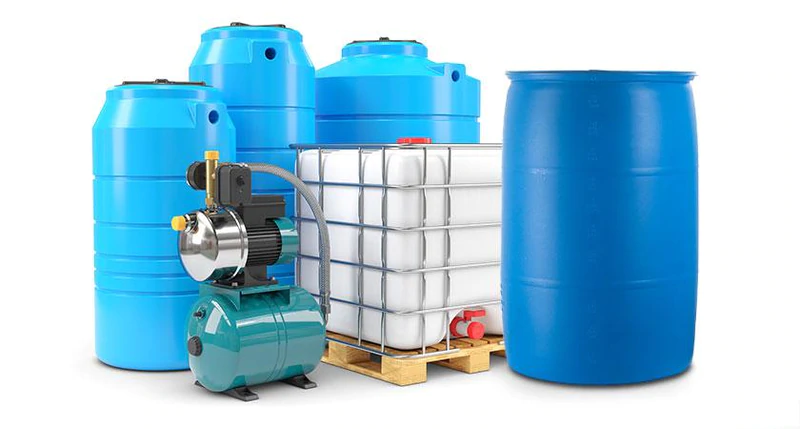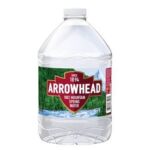
By now you should have a three-month supply of food and extra supplies at your fingertips. Now it is time to move to our second step, and that is storing water.
STEP TWO – WATER STORAGE
We can only survive for a few days without water. Dehydration can cause serious damage to our body and lead to death within 3-4 days. Water is the most important and necessary item to have in an emergency.
HOW MUCH WATER DO I NEED?
How much water do you need? FEMA recommends storing at least one gallon of water per person, per day, for a two-week period. In an emergency or a water service disruption, you will need water for drinking, hygiene, and cooking.
For a family of four, a two-week water supply equals 56 gallons of water to be stored.
This is the minimum amount, but you should contemplate keeping more if you have the resources to do so.
NOTE: You will need to store drinking water in addition to water for hygiene and cooking.
DRINKING WATER vs WATER FOR COOKING AND CLEANING
Commercially bottled water is the safest and easiest way to store water for drinking. Consider keeping bottled water and gallon jugs for drinking.
You would not want to use bottled water for cooking or cleaning. First, it is a waste of pure drinking water. Second, it would produce too much waste. For cooking and cleaning, consider storing water in large storage containers.
TYPES OF WATER STORAGE CONTAINERS
Water storage containers are available in various sizes. Ensure that they are food-grade storage containers and have a top that can be closed tightly. These containers can be found at camping stores and emergency supply centers. If you decide to reuse storage containers, choose two-liter plastic soft drink bottles.
Do not reuse plastic jugs or cardboard containers that contained milk or fruit juice.
Only use food-grade plastic containers made from high-density polyethylene (HDPE) or polyethylene terephthalate (PET). Look for a triangle with the numbers 1, 2, 4, or 5 on the bottom of the plastic container.
Using a variety of container sizes may be the best way to store water for your family.
Potential WaTER storage containers:
- Water bottles of gallon jugs commercially purchased
- 4-gallon water bricks
- 6-gallon water containers
- 55-gallon water barrels




Commercial water bottles and gallon jugs
Grab a few cases of bottled water the next time you are at Costco or Sam’s Club. You can also purchase gallon size drinking water available at any supermarket. I would recommend spending a few extra cents for the name brand containers that are heavier plastic.

These types of containers are easily portable if you need to evacuate your home.
Water bricks
Water bricks can be stacked in smaller containers, usually 3-4 gallons. These are easy to manage and use. Many stores carry these containers, and they can also be purchased online at stores such as Food Storage Depot.
5-gallon and 6-gallon water containers
There are many 4 – 6 gallon water containers like this one from Igloo, and they are portable and easy to manage. These containers can be found at camping supply stores and in the camping section of big box stores like Walmart.
https://www.igloocoolers.com/products/42154-6-gallon-water-container-ii-blue
HOW TO CLEAND AND FILL SMALLER WATER CONTAINERS
It is important to clean and sanitize water storage containers before use. The CDC website has great tips and are included here:
- Wash the storage container and rinse thoroughly with water.
- Sanitize the container with a solution by mixing one teaspoon of unscented liquid household chlorine bleach in 1 quart of water. Use bleach that contains 5%–9% sodium hypochlorite.
- Cover the container tightly and shake it well. Make sure the sanitizing bleach solution touches all inside surfaces of the container.
- Wait at least 30 seconds, then pour the sanitizing solution out of the container.
- Let the empty sanitized container air-dry before use OR rinse the empty container with safe water (water that has been treated).
- Pour clean water into the sanitized container and cover with a tight lid.
Some other helpful tips include:
- Marking your containers as “drinking water.”
- Mark the containers with the date filled.
- Note if the water was treated (i.e., with bleach).
- Store in a dark, cool place away from gasoline and pesticides.
Other tips and tricks:
- Store water in your laundry detergent containers once used and emptied. This is a great source of cleaning water. (Make sure to mark with Sharpie “cleaning water.”)
- Fill up sports bottles with water and store in the fridge or basement.
LARGE WATER STORAGE CONTAINERS
55 to 160-gallon water tanks with spouts are an excellent option for easy access to large amounts of water. Many are stackable to optimize space.
There is a great selection of large water barrels at the Food Storage Depot.
https://www.foodstoragedepot.com/55-gallon-water-tank-stackable-w-spout/
HOW TO FILL LARGE WATER BARRELS
Many are intimidated by the size and sheer volume of the 55-gallon barrels, or simply don’t know how to use them. Let’s break it down.
First – clean it
You will want to clean out the barrel before filling with water. Simply add a few gallons of water to the barrel with about 1/8 of bleach. Put the lid on and place the barrel on its side. Roll the barrel around to coat the inside with the bleach mixture.
Second – dump out the cleaning water
Third – move the empty barrel to the location you plan on storing it
Try to find a cool, dark, and dry area. You will not be able to move the barrel once it is full of water, so be sure of your location.
Fourth – fill up the barrel
Note: It is recommended that you use a food-grade hose when filling up your barrel. If you use a garden hose, you risk not getting clean water which could encourage harmful bacterial growth in the water barrel.
A boat or camper hose is designed for drinking water use. Food-grade hoses are more expensive than a garden hose but worth the peace of mind. These can be found at home improvement stores or online.
Attach the hose to a potable water source, either to an outside hose bibb or an indoor faucet. If your inside faucet can’t attach directly to the hose, you may need to purchase a converter from a home improvement store.
Fill er up! This may take a while, so make a note of the time for future reference.
You can treat the water to make sure that the water has not been contaminated accidentally by using ¼ cup of bleach for a 55-gallon container. Because bleach has a short shelf life, you will need to rotate the water every year or so.
BLEACH ALTERNATIVE
Aquamira is an alternative to bleach with a 5-year shelf life and enhances the taste of the treated water. It is more expensive but may be worth the cost in the long run.
https://www.aquamira.com/product/aquamira-water-treatment-2-oz-glass-with-droppers/
How to access water in an Emergency from big barrels
You may have a large barrel that does not come with a valve already attached. (Consider spending the extra money if you are in the market for a new water barrel. It makes using the water so much easier).
- If the barrel does not have a valve, you will need to siphon water from the top.
- When you need to use the water, start by making sure the top of the barrel is clean. You want to keep the water as clean as possible.
- Once the top of the barrel is clean, open one of the bungs (plugs) on the top of the barrel. The barrels usually have two bungs which can be challenging to open. A bung wrench or channel lock pliers may be required to open the plugs.
- Insert a clean siphon or hand pump into the water barrel. If you do not have a pump, the water may be siphoned out using a tube or hose. Make sure you use a clean hose made for water (food grade) if possible.
- Pump water into a pitcher or a smaller water storage container. Carefully examine the water. It should look and smell like clean drinking water. Filter the water before drinking if you have any concerns.
Here are some great resources for materials to extract water from barrels.
Check out this site for siphons and hand pumps from The Home Depot:
https://www.homedepot.com/b/Plumbing-Water-Pumps-Utility-Pumps/Siphon-King/N-5yc1vZbqn6Zdxm
Learn about and purchase bung wrench here:
https://www.grainger.com/category/tools/hand-tools/wrenches/drum-bung-plug-wrenches
This article is an excellent resource for this procedure.
Water is the most important item that you need to store. Don’t delay on completing this step!

